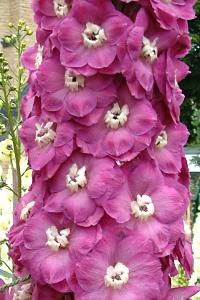 SECTIONS
SECTIONS| Return to Introduction | Return to Home Page |
Delphiniums from Seed 2Breeding delphiniums with dusky pink flowers |
 SECTIONS
SECTIONS
Our interest in delphiniums with pink flowers began more than thirty years ago, when we purchased the variety 'Turkish Delight' from the raisers, Blackmore & Langdon. The colour of this cultivar is really pale mauve rather than pink and it also fades badly in sunlight. These still remain common problems of dusky-pink delphinium flowers that we try to improve by:-
This account illustrates stages in our progress from 'Turkish Delight' to the seedlings grown in 2002, such as that shown in the picture above.
| Return to Section Headings List |
Raising and Introducing New Cultivars
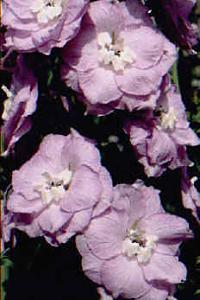 'Turkish Delight' was an attractive
addition to our herbaceous border but it was the only delphinium
in our collection with flowers in a pink shade. Bearing in mind
that pink colouring
of the sepals of delphinium flowers is a recessive genetic trait, there were two approaches that we
could have adopted to obtain seedlings with pink flowers:
'Turkish Delight' was an attractive
addition to our herbaceous border but it was the only delphinium
in our collection with flowers in a pink shade. Bearing in mind
that pink colouring
of the sepals of delphinium flowers is a recessive genetic trait, there were two approaches that we
could have adopted to obtain seedlings with pink flowers:
The first approach has the advantage that self-pollinated seed from 'Turkish Delight' should give seedlings with flowers in dusky pink shades. If you assume that open-pollinated seed is to some extent the result of self-pollination, then you could make a start using seed just collected from a plant of 'Turkish Delight' in the garden. It would be preferable to ensure that the seed is truly the result of self pollination by pollinating an emasculated floret of this cultivar with pollen taken from another floret on the plant.
The second approach was adopted. 'Turkish Delight' was crossed to another cultivar with desirable features and we retained a small selection of plants with good features from the batch of seedlings grown. None of this first generation of seedlings had pink flowers, because pink flowers are recessive. Pink flowers were recovered either in back crosses to 'Turkish Delight' or in crosses between the selected seedlings.
Our first cross used 'Cinderella', which had neat blooms in a light violet shade. None of the seedlings raised had pink flowers. Nevertheless, 'Emily Hawkins', a plant with violet flowers raised from a subsequent generation, still retains the potential to yield pink-flowered seedlings when crossed to a dusky-pink variety. It is interesting to notice the marked resemblance in floret form between 'Turkish Delight' and 'Emily Hawkins'.
One seedling from 'Cinderella' x 'Turkish Delight' had creamy white flowers and a neat spike. The creamy-white colour is also strongly recessive and a backcross to 'Turkish Delight' gave seedlings with flowers in pink shades. The best of these was used in further crosses which led to a steady improvement in the quality of the flowers.
As in the case of self pollination, seed from crossing 'Turkish Delight' with another pink-flowered cultivar should yield seedlings with pink flowers. We used 'Strawberry Fair', the first Blackmore & Langdon variety to have very deep pink or claret colour. We did not grow this variety ourselves but purchased a packet of hand-pollinated seed of 'Turkish Delight' x 'Strawberry Fair' from the Delphinium Society. That provided some seedlings with deep pink flowers that we then crossed with paler pink flowered plants obtained from our earlier crosses using 'Turkish Delight'.
Buying a packet of hand-pollinated seed from a specialist source, such as the Delphinium Society is a useful way to introduce genes from plants not in your collection
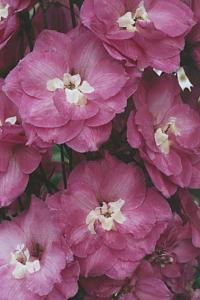 A second opportunity to obtain the
genetic characteristics of another dusky pink cultivar occurred
after a delphinium show. A competitor allowed us to take home his
beautiful bloom of 'Royal
Flush', seen in
the picture here. Kept in
water, the bloom
provided a pollen source for several days and we succeeded in making a cross to
the best of our own line of pink-flowered plants. That cross
produced some excellent seedlings having deep dusky pink flowers
with white eyes. The best selected plants were used as the seed
parent in more crosses for pink flowers.
A second opportunity to obtain the
genetic characteristics of another dusky pink cultivar occurred
after a delphinium show. A competitor allowed us to take home his
beautiful bloom of 'Royal
Flush', seen in
the picture here. Kept in
water, the bloom
provided a pollen source for several days and we succeeded in making a cross to
the best of our own line of pink-flowered plants. That cross
produced some excellent seedlings having deep dusky pink flowers
with white eyes. The best selected plants were used as the seed
parent in more crosses for pink flowers.
Persuading a friend to provide a bloom or a few florets as a source of pollen from a variety that you do not grow is a useful way to widen the range of crosses that can be made on your plants.
Crosses between pink-related cultivars
'Emily Hawkins' x 'Gillian Dallas'
A further line opened when we found to our surprise that crossing 'Emily Hawkins' with the beautiful pale violet variety, 'Gillian Dallas' gave some seedlings having flowers in a muddy or blued shade of pink. One seedling, GXG7, was very tall and vigorous with florets in the style of 'Turkish Delight'. We kept that for some 20 years and used it in many crosses.
The best results were from a cross to another plant with large flat florets of a deep dusky pink colour. The whole row of seedlings in 1980 was an exciting advance on crosses we had grown previously. We selected one plant that had a shorter growth habit than most and a neat compact bloom with florets of a deep dusky pink. This plant propagated easily and attracted the attention of other delphinium enthusiats. It was accepted for inclusion in the Delphinium Trial at the Royal Horticultural Society's Garden at Wisley and, after gaining Awards in the Trial, was named 'Rosemary Brock'.
Two other paler pinks with brown eyes were selected from related crosses grown in 1982. These were subsequently named 'Summerfield Miranda' and 'Summerfield Diana'. These plants are described in the pages for 'Summerfield Delphiniums'.
| Return to Section Headings List |
It is a fair question to ask why we have not named any more pink-flowered Summerfield delphiniums. We have made many crosses and raised many seedlings in trying to obtain dusky pink flowers of brighter and deeper colour, especially flowers with a white eye. Although some very attractive flowers have been obtained, most have not represented a sufficient advance on existing named cultivars to justify naming. We illustrate here some of the lines pursued.
Seed Parents and Crosses
'Rosemary Brock' is an excellent parent for dusky pinks, especially as the seed parent since it provides large yields of seed that germinates easily. It carries the recessive gene for cream-yellow flowers and can also be used in crosses for creams with brown eyes.
'Lucia Sahin'. It is interesting to note that this mulberry pink with a dark eye raised by Duncan McGlashan resulted from crossing 'Rosemary Brock' with 'Summer Wine', another deep dusky pink with white eye. We have been using this Cultivar as a cross parent since 1998. 'Summer Wine' did not flourish in our garden and it did not give us any useful seedlings.
'Royal Flush' is a useful parent for dusky pinks when a white eye is required, although imperfections in the floret form tend to be transferred to seedlings. It is probably best used as a pollen parent rather than as a seed parent since seed yields are often poor and germination of seed from this cultivar often gives problems. This plant also carries the recessive gene for cream and yields a high proportion of seedlings having cream flowers with yellow eyes when crossed to a cultivar with cream flowers.
'Cherub' is a reliable producer of freely germinating seed and is useful as a seed parent in crosses for light pinks with white eyes.
'Summerfield Miranda' is not a reliable producer of seed and we would use this cultivar as a pollen parent only when the flat floret form is important.
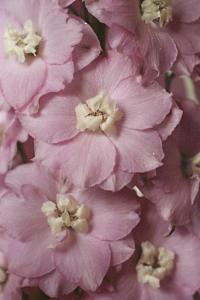 |
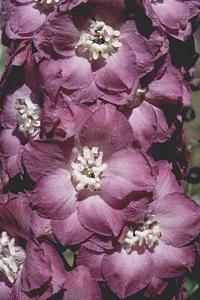 |
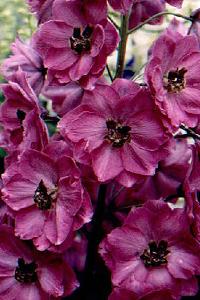 |
Selected seedlings from crosses between such named cultivars and plants raised in the first phase have also been used frequently as parents for crosses. Three of these are shown in the pictures above.
The light pink with a white eye in the left hand picture flowers late in the season and produces long spikes. The darker pink with white eye in the centre has a rather short bloom on a tall plant but is useful in raising deep pinks with white eyes, for example by crossing it to 'Lucia Sahin'.
The right hand picture shows a seedling having the deepest mulberry pink florets we have found. The colour was beautiful but the pedicels of the florets were too thin to support the flowers when wet with rain. Nevertheless, we used the flowers in some crosses for deep pinks with dark eyes in the hope that the good qualities could be retained.
To regain the clarity of pinks that we had achieved ten years ago, we have in the last two seasons grown seed of crosses made some years ago and kept in refrigerated storage. We have also continued with crosses using 'Lucia Sahin' for deep pinks with white eyes.
The pictures below show flowers in July2002 of seedlings selected the previous autumn.
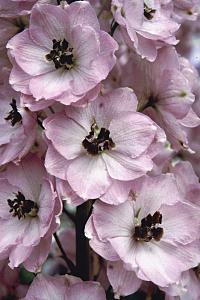 |
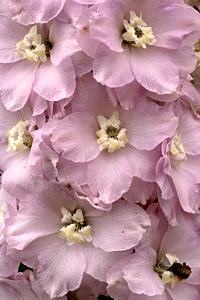 |
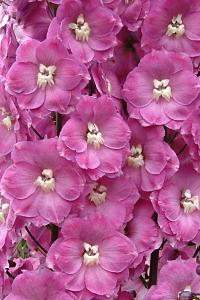 |
The left hand picture shows a seedling that produced blooms of excellent form, one winning a prize at the Delphinium Society Show. The centre picture shows the florets of a tall pale pink seedling raised from an old cross. The colour was good but the open centre to the eye is a bad feature. The right hand picture and the picture at the page heading illustrate the good floret form of pink delphiniums with white eyes that are related to 'Lucia Sahin'. Ugly petal spurs exposed in the face of the floret are a bad feature of many seedlings from crosses involving 'Lucia Sahin'.
Pink-related Parents
It should be apparent from the quite small range of pink cultivars used in our crossing program that we are fishing in a rather limited genetic pool and it would be nice if we could widen this. In the last few seasons we tried crosses to 'Min', for example. This cultivar produces superb spikes of pale violet flowers but the International Delphinium Register shows that it has the pink-flowered variety 'Circe' as a grandparent. Crosses with 'Min' indeed yield flowers in pink shades coupled to exhibition-style spikes but they are a backward step in the sense that the colours tend to be either muddy or heavily blued.
Our pink-tinted white, 'Blackberry Ice' also yields seedlings with pink flowers but ugly spurs across the face of florets are a frequent feature of these plants.
Colour Fading
It is always fun to have new pink seedlings to look at but the hard light of mid-day is never flattering. The flowers can often seem horribly blued even if there is little fading. We find that late evening or early morning is much the best time to walk round our pink seedlings. Somehow the red seems to be enhanced and you can indulge in 'make belief' that you have a true red delphinium!
You would think dusky pink delphiniums were the only flowers to suffer colour fading from the way some people denigrate them. However, any grower of exhibition chrysanthemums knows that varieties with pink flowers usually fade in strong sunshine and it is normal practice to use shade netting to minimise such bleaching. The pink colours in chrysanthemums also tend to be blued and a clear pink flower would be just as much a triumph for the breeder as it is with delphiniums.
It is advantageous to site dusky pinks where they will be shaded during the hottest part of the day. This reduces the rate of sun bleaching of the colour, which is particularly important if blooms are required for a flower show.
| Return to Section Headings List |
| Return to Introduction | Return to Home Page |